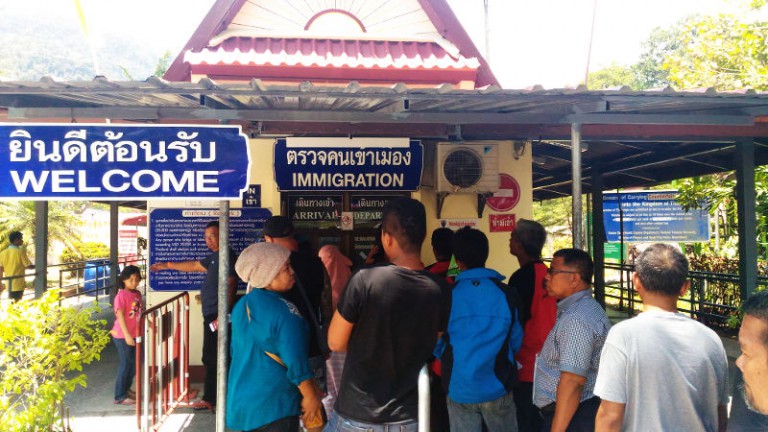Thailand has long been a top destination for tourists, digital nomads, and expatriates alike. With its stunning landscapes, affordable lifestyle, and vibrant culture, it’s no surprise that people often want to extend their stay. However, the process of staying in Thailand for extended periods can sometimes lead travelers to engage in what’s commonly referred to as a “border run.” While this tactic has been widely used, it’s important to understand both the process and the potential risks, including the possibility of being rejected entry for repeated border runs.
What Is a Border Run?
A border run involves leaving Thailand briefly to cross into a neighboring country, then re-entering Thailand to obtain a new visa or a visa-exempt entry. This is typically done when someone’s current visa or visa-exempt period is about to expire but they wish to stay longer.
There are two main reasons for border runs:
- Extending a Visa: Travelers with a tourist visa or visa-exempt entry may do a border run to reset their permitted duration of stay.
- Switching to a New Visa: Some individuals exit the country to apply for a different type of visa, such as a Non-Immigrant Visa, from a Thai consulate in a neighboring country.
Popular Border Run Destinations
Thailand shares borders with several countries that are commonly used for border runs:
- Malaysia: The border town of Padang Besar is a popular crossing point.
- Cambodia: Aranyaprathet (Poipet border) is one of the busiest border points.
- Laos: Vientiane is a favorite destination for obtaining Thai visas at the consulate.
- Myanmar: Mae Sai (Tachileik border) is a common choice for northern Thailand residents.
Border runs can be completed in a single day or over a couple of days, depending on the location and mode of transport.
How Do Border Runs Work?
- Plan Your Trip: Research the border crossing and understand the requirements for entry into the neighboring country. Make sure your passport has at least six months of validity and blank pages for stamps.
- Exit Thailand: Travel to the border, check out of Thailand, and enter the neighboring country. Some crossings require a short stay or fee in the neighboring country.
- Re-enter Thailand: Upon returning, you may be granted a new visa-exempt entry or use a valid Thai visa for re-entry.
- Ensure Compliance: Always check the Thai immigration rules beforehand to ensure you meet the criteria for re-entry.
Risks of Too Many Border Runs
While border runs can seem like an easy solution for staying in Thailand, there are significant risks involved, particularly for those who engage in them frequently.
1. Increased Scrutiny at Immigration
Thai immigration officers are increasingly vigilant about repeated border runs. Frequent border crossings may raise red flags, as they indicate an attempt to stay in Thailand long-term without obtaining the appropriate visa.
Signs of concern include:
- Multiple border run stamps in your passport.
- Lack of evidence supporting legitimate reasons for your stay (e.g., tourism, work, or family).
- Short turnaround times between entries and exits.
2. Denial of Entry
If immigration officers suspect that you’re using border runs to overstay your welcome or circumvent visa rules, they have the authority to deny you entry. A denial of entry can be distressing and may result in:
- Immediate return to the country you just exited.
- Being blacklisted from entering Thailand in the future.
3. Requirement to Show Proof of Funds and Intent
To assess the legitimacy of your stay, officers may ask for:
- Proof of funds to support yourself during your visit.
- A confirmed outbound flight ticket to prove you plan to leave Thailand.
- Hotel bookings or an address where you will be staying.
4. Overstay Penalties
If a border run is unsuccessful or delayed, you may inadvertently overstay your visa. Thai immigration imposes strict penalties for overstays, including:
- Fines of 500 THB per day (up to a maximum of 20,000 THB).
- Risk of being detained or banned from re-entering Thailand.
5. Damage to Your Travel Record
A history of frequent border runs and potential entry denials may harm your future travel plans. Some countries may scrutinize your travel history when issuing visas, particularly if they see patterns of extended stays in Thailand.
How to Avoid Border Run Issues
- Obtain a Long-Term Visa Consider applying for a long-term visa that matches your purpose for staying in Thailand. Options include:
- Education Visa
- Retirement Visa
- Non-Immigrant B Visa for work
- Elite Visa for extended stays without frequent renewals
- Limit the Frequency of Border Runs Avoid relying on border runs as a long-term solution. If you need to do one, space them out to minimize suspicion.
- Provide Documentation When re-entering Thailand, carry documents to justify your stay, such as:
- A detailed travel itinerary.
- Proof of financial stability.
- Evidence of genuine tourist activities or work commitments.
- Use a Visa Agent If you’re unsure about the rules or processes, a reputable visa agent can help ensure your compliance with Thai immigration policies.
Conclusion
Border runs have long been a convenient way for travelers to extend their time in Thailand. However, with increasing immigration scrutiny, relying on border runs carries significant risks. Understanding the rules and being prepared can help you avoid complications, but for a more secure and stress-free stay, consider obtaining the appropriate visa for your needs. By respecting Thailand’s immigration policies, you can continue to enjoy all that this beautiful country has to offer.




1 Comment
In 2023, I attempted a border run from Thailand to Cambodia to extend my stay in Thailand. The trip started smoothly; I crossed into Cambodia, spent a few hours there, and then returned to the Thai border.
When I approached Thai immigration for re-entry, the officer reviewed my passport and noted the frequent border runs over the past months. Despite explaining that I was a tourist who loved visiting Thailand, they flagged me for attempting to use border runs to stay long-term.
The officer denied me entry, stamped “ENTRY DENIED” in my passport, and instructed me to return to Cambodia. It was a moment of shock and frustration, as I was not prepared for this outcome.
With no choice but to comply, I returned to Cambodia and had to quickly arrange a flight back to my home country. This experience taught me the importance of respecting visa regulations and not over-relying on border runs as a long-term strategy for staying in Thailand.